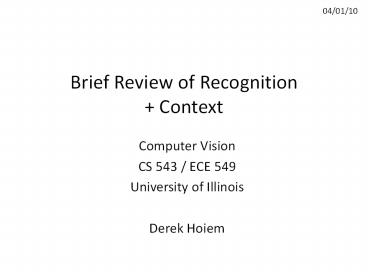Brief Review of Recognition Context - PowerPoint PPT Presentation
Title:
Brief Review of Recognition Context
Description:
04/01/10 Brief Review of Recognition + Context Computer Vision CS 543 / ECE 549 University of Illinois Derek Hoiem Object Instance Recognition Want to recognize the ... – PowerPoint PPT presentation
Number of Views:164
Avg rating:3.0/5.0
Title: Brief Review of Recognition Context
1
Brief Review of Recognition Context
04/01/10
- Computer Vision
- CS 543 / ECE 549
- University of Illinois
- Derek Hoiem
2
Object Instance Recognition
- Want to recognize the same or equivalent object
instance, which may vary - Slight deformations
- Change in lighting
- Occlusion
- Rotation, rescaling, translation, perspective
3
Object Instance Recognition
- Template matching faces
- Recognize by directly computing pixel distance of
aligned faces - Principal component analysis gives a subspace
that preserves variance - Linear Discriminant Analysis (LDA) or Fisher
Linear Discriminants (FLD) gives a subspace that
maximizes discrimination - This could work for other kinds of aligned objects
4
Object Instance Recognition
- If object is not aligned, we need to perform
geometric matching - Find distinctive and repeatable keypoints
- E.g., Difference of Gaussian, Harris corners, or
MSER regions - Represent the appearance at these points (e.g.,
SIFT) - Match pairs of keypoints
- Estimate transformation (e.g., rotation, scale,
translation) from matched keypoints - Hough voting
- Geometric refinement
- Clustering (visual words) and inverse document
frequency enable fast search in large datasets
5
Category recognition
- Instances across categories tend to vary in more
challenging ways than a single instance across
images
6
Image Categorization
- In training, a classifier is trained for a
particular feature representation using labeled
examples - The features should generally capture local
patterns but with loose spatial encoding - For scene categorization, a reasonable choice is
often - Compute visual words (detect interest points,
represent them with SIFT, and cluster) - Compute a spatial pyramid of these visual words,
composed of histograms at different spatial
resolutions - Train a linear SVM classifier or one with a
Chi-squared kernel
7
Object Category Detection
- One difficulty of object category detection is
that objects could appear at many scales or
translations, and keypoint matching will be
unreliable - A simple way around this is to treat category
detection as a series of image categorization
tasks, breaking up the image into thousands of
windows and applying a binary classifier to each - Often, the object is classified using edge-based
features whose positions are defined at fixed
position in the sliding window
Object or Background?
8
Object Category Detection
- Sliding windows might work well for rigid objects
- But some objects may be better thought of as
spatial arrangements of parts
9
Object Category Detection
- Part-based models have three key components
- Part definition and appearance model
- Model of geometry or layout of parts
- Algorithm for efficient search
- ISM Model
- Parts are clustered detected keypoints
- Position of each part wrt object center/size is
recorded - Search is done through Hough voting / Mean-shift
clustering combination - Pictorial structures model
- Parts are rectangles detected in silhouette
- Layout is articulated model with tree-shaped
graph - Search through dynamic programming or
probabilistic sampling
10
Region-based recognition
- Sometimes, we want to label image pixels or
regions - Basic approach
- Segment the image into blocks, superpixels, or
regions - Represent each region with histograms of
keypoints, color, texture, and position - Classify each region (variety of classifiers used)
11
Context in Recognition
- Objects usually are surrounded by a scene that
can provide context in the form of naerby
objects, surfaces, scene category, geometry, etc.
12
Context provides clues for function
- What is this?
These examples from Antonio Torralba
13
Context provides clues for function
- What is this?
- Now can you tell?
14
Sometimes context is the major component of
recognition
- What is this?
15
Sometimes context is the major component of
recognition
- What is this?
- Now can you tell?
16
More Low-Res
- What are these blobs?
17
More Low-Res
- The same pixels! (a car)
18
We will see more on context later































